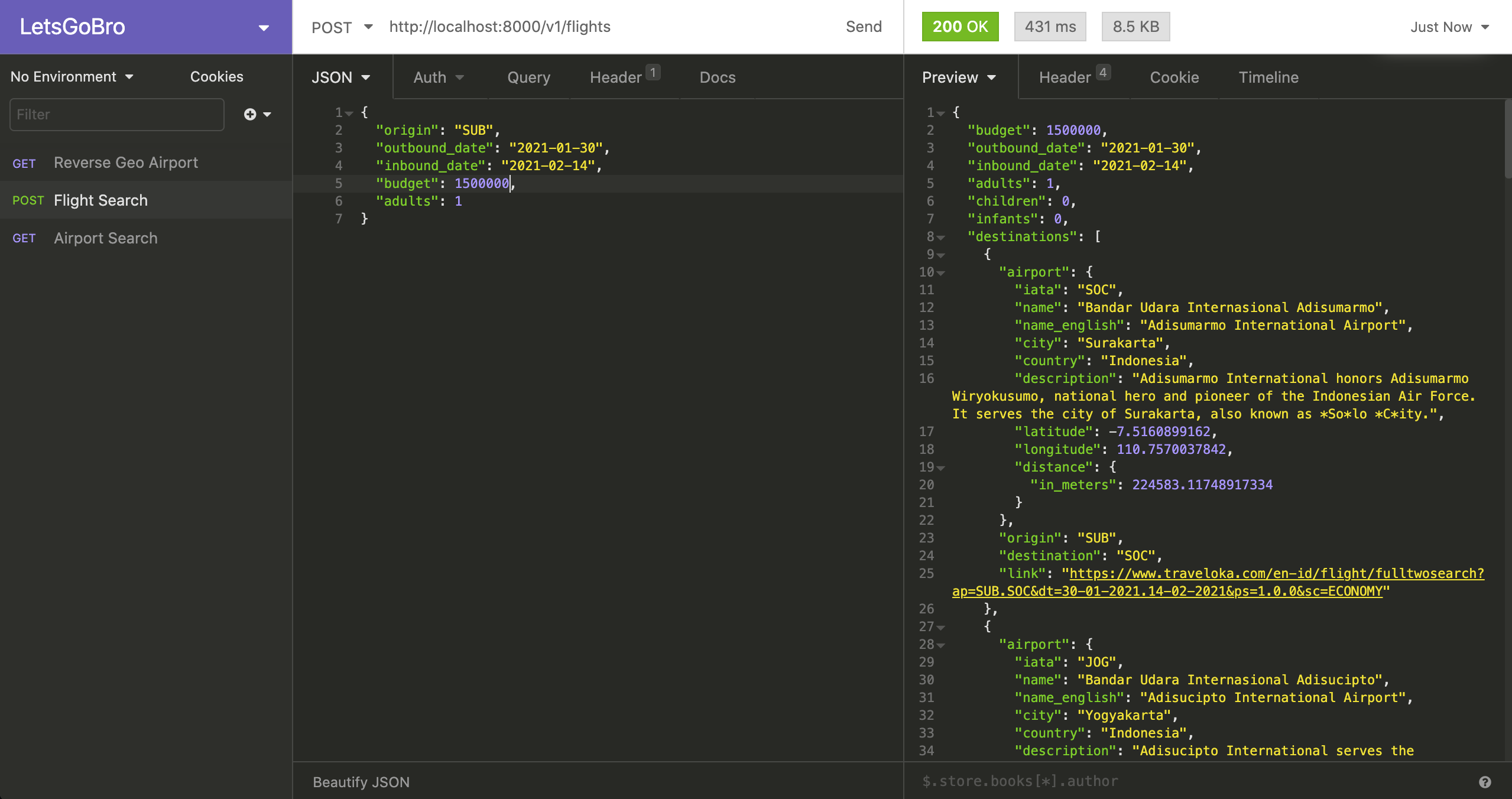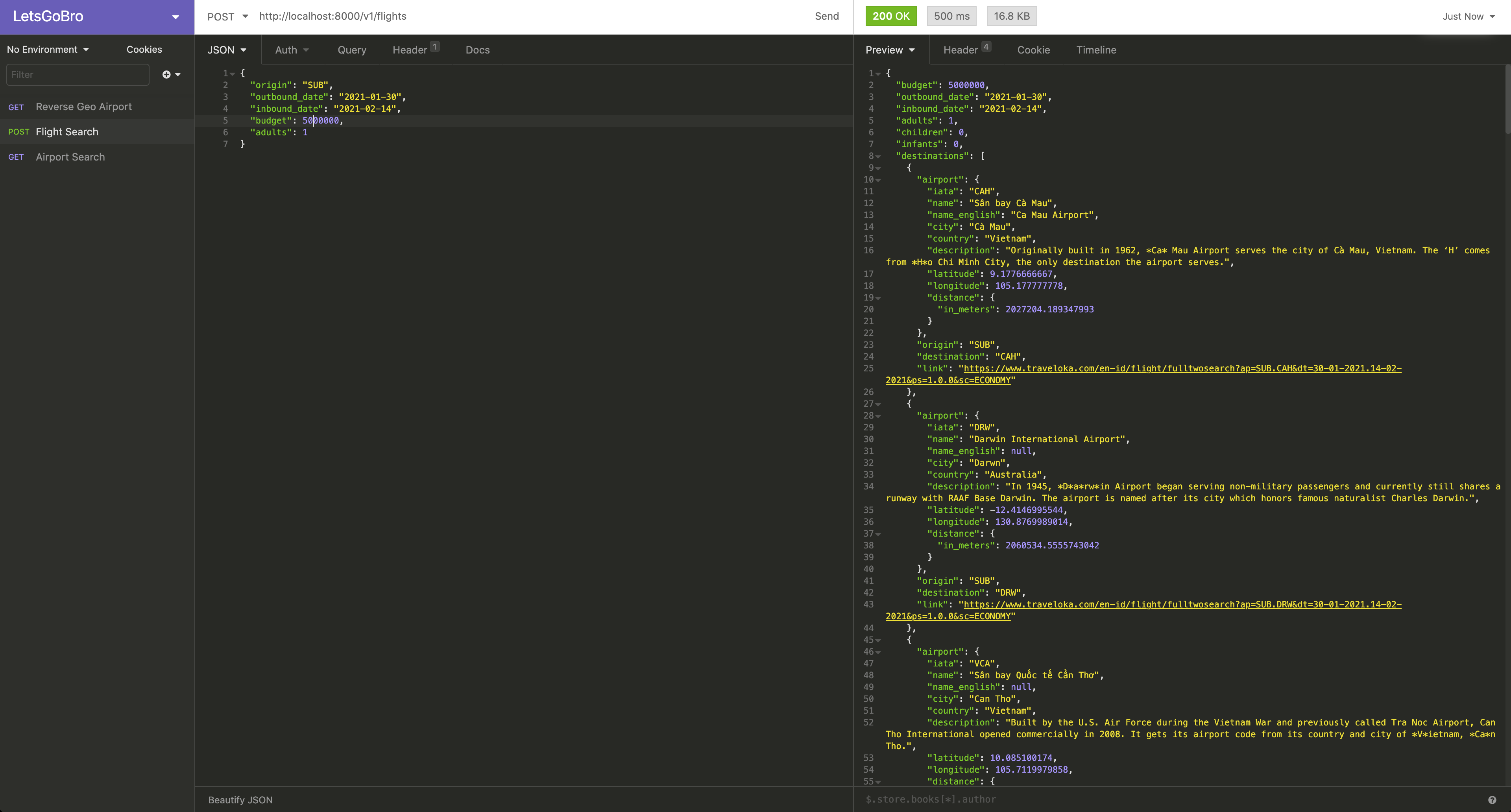A few days ago I published a Python Sanic backend and an Android app of a weekend project I did a few years ago. The project was simply directing people to a random cheapest return flights from where they are, set a budget and just press Go. It was written when async Python was beginning to mature. So I thought why not learn something new (FastAPI) and compare it with Sanic.
This is the Android app https://t.co/bA2cBt7SyS
— Batista Harahap (@tista) December 31, 2020
Let’s Go Bro!
Here’s a link to the repository. The README.md covers how to run the API while here I wanna focus on the journey. As I write this, the end result is not even 24 hours old so memory is still fresh.
PyDantic
PyDantic is foundation of FastAPI. Request/Response are modeled with it including with validations. That said, it’s reusable across the entire codebase which makes responses consistent. BIG PLUS!
I made a typical noob mistake with it.
class Airport(BaseModel):
iata = str
name = strclass Airport(BaseModel):
iata: str
name: strSaw which one is wrong? Took me a bit to get used to modeling with native python types. I like it!
Routing
Coming from Flask and Sanic, when building APIs, I’m used to declaring endpoints explicitly. In FastAPI, it’s just another (decorated) function or at least that’s how it seems.
Airports = APIRouter()
@Airports.get('/airports', response_model=List[AirportResponse])
async def airports(latitude: float, longitude: float, max_distance_in_km: int = 50):
await connect_to_mongodb()
nearest_airports = await Airport.find_nearest_airport(latitude=latitude,
longitude=longitude,
max_distance_in_km=max_distance_in_km)
await disconnect_mongodb()
return nearest_airportsLooking at the flow of the codes, this is pretty much how it flows too when I code backends with RxJS. Since FastAPI is still new, there are not much libraries out there yet. Had the choice of using Motor but I stuck with MongoEngine since I wanted to learn about FastAPI first. Had to be careful to code database connection and queries correctly using a sync library on an async environment.
The codes above are for GET requests with query parameters, let’s see how a POST request looks like.
@Flights.post('/flights', response_model=FlightSearchResponse)
async def flights(request: FlightSearchRequest):
await connect_to_mongodb()
min_distance_in_km, max_distance_in_km = get_distances_from_budget(budget=request.budget)
destinations = await Airport.find_destinations(origin=request.origin,
min_distance_in_km=min_distance_in_km,
max_distance_in_km=max_distance_in_km)
def _build_destination(origin: str, destination: dict, departure_date: str, returning_date: str, adults: int,
children: int, infants: int):
forward_link = forward(origin=origin,
destination=destination.get('iata'),
departure_date=departure_date,
returning_date=returning_date,
adults=adults,
children=children,
infants=infants)
return {
'airport': destination,
'origin': origin,
'destination': destination.get('iata'),
'link': forward_link
}
destinations = [_build_destination(origin=request.origin,
destination=row,
departure_date=request.outbound_date,
returning_date=request.inbound_date,
adults=request.adults,
children=request.children,
infants=request.infants) for row in destinations]
await disconnect_mongodb()
return {
'budget': request.budget,
'outbound_date': request.outbound_date,
'inbound_date': request.inbound_date,
'adults': request.adults,
'children': request.children,
'infants': request.infants,
'destinations': destinations
}It’s so simple right? The function focuses on the flow only. Could’ve hidden some complexity out of the function though.
Flight Search
Let’s take a look what the client needs to do to get flight recommendations.
Find Nearest Airport

I acknowledge that the closest might not be the most suitable. The request above is made with Monas coordinates. There are more options from CGK compared to HLP so the choice of airport is at the client’s discretion.
Get Flight Recommendations

With IDR 1.5 mio, most of the recommendations are local destinations. What happens with IDR 5 mio? Let’s have a look!

I chose SUB as the origin, there isn’t much international flight destinations from there but then the API still shows up non-direct routes. The flight recommendations works on a radius based on the budget. Here are the codes.
def get_distances_from_budget(budget: int):
distances = (100, 1000)
if 0 < budget <= 1500000:
distances = (100, 1000)
elif 1500000 < budget <= 2000000:
distances = (800, 1250)
elif 2000000 < budget <= 3000000:
distances = (1000, 1750)
elif 3000000 < budget <= 4000000:
distances = (1500, 2250)
elif 4000000 < budget <= 5000000:
distances = (2000, 2750)
elif 5000000 < budget <= 6000000:
distances = (2500, 3250)
elif 6000000 < budget <= 7000000:
distances = (3000, 3750)
else:
distances = (3500, 15000)
return distancesIt’s just a rule engine but an effective one. The logic above was coded 4 years ago and still rings true today.
Try it!
$ git clone git@github.com:tistaharahap/letsgobro-api.git
$ cd letsgobro-api
$ virtualenv env
$ . env/bin/activate
$ pip install -r requirements.txt
$ MONGO_USER=user MONGO_PASSWORD=password MONGO_HOST=host MONGO_DB=db python scripts/airports.py # seed mongodb, only needed once
$ MONGO_USER=user MONGO_PASSWORD=password MONGO_HOST=host MONGO_DB=db python app.pyI used MongoDB Atlas’ Free tier since this is just a weekend project. You should try too.
Thinking about doing a frontend for it but I don’t think I will. A REST client will do the job for me when I need recommendations.